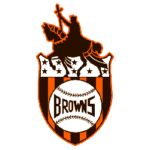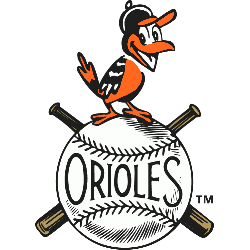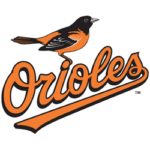The Baltimore Orioles, a renowned baseball club, is known for its sportsmanship and captivating logo that resonates with the essence of Maryland. Over the years, the logo has evolved, tracing a rich history alongside the team’s journey. This article delves deep into the history, unearthing the evolution of the Orioles logo, a story that every baseball fan would love to know.
Origin and Early Years

St. Louis Browns Primary Logo 1936 - 1951
The initial phase of any sports team’s logo offers a glimpse into its foundational ethos and roots. The Baltimore Orioles were no exception. Their original logo was simple but spoke volumes about the team’s connection with its home state. At the beginning of the 20th century, most teams used the wordmark of their state or hometown as their logo. Hence, the first Milwaukee Brewers’ logo was just the blue-written name of the city. In 1902, the team was still known as the St. Louis Browns, a name that influenced their branding for several decades, resulting in unique logos that encapsulated the spirit of St. Louis.
Struggles and Changes
Like many sports teams, the Baltimore Orioles experienced tumultuous times, leading to relocation and rebranding. During these challenging periods, their logo often reflected the team’s aspiration for change and new beginnings.
Throughout the early and mid-20th century, the team underwent several transitions, including changes in ownership and attempts to move to different cities. Each era brought with it a unique branding decision. Bill Veeck’s tenure was not just about baseball; it was about entertainment. His promotional tactics and branding decisions changed the game, making an indelible mark on the team’s identity.
A New Home in Baltimore

Baltimore Orioles Primary Logo 1954 - 1965
Every relocation in sports often leads to rebranding to align with the new home. The Orioles’ move to Baltimore was pivotal, leading to an evolution in their logo that echoed the city’s essence. The St. Louis Browns were immediately renamed the Baltimore Orioles after their transfer to Baltimore. The transition led to branding decisions shaping the team’s identity for years. The introduction of the bird in the Orioles' logo was a significant development. It connected the team with Maryland’s state bird and added a vibrant charm to the team’s brand.
The Era of the Cartoon Bird
The cartoon-style logos are captivating and resonate well with a broader audience. The Orioles adopted this trend, introducing a cartoon bird that would become an iconic symbol in baseball. In 1966, the cartoon bird made its debut, bringing a fresh, youthful vibe to the Orioles brand. This logo remained a fan favorite for decades.
While the cartoon bird was adored, the late 80s shifted towards a realistic bird representation, reflecting the team’s desire for a mature branding approach.
Modern Era and Logo Refinements

Baltimore Orioles Primary Logo 2009 - 2018
The turn of the century ushered in an era of digital design and modern aesthetics. The Orioles, staying true to the times, adapted their logos to reflect contemporary design philosophies. From 1992 onwards, the team favored a realistic depiction of the Oriole. This phase added a touch of sophistication to the team’s branding, with meticulous details bringing the bird to life.
In the late 2010s, the Orioles revisited some of their past designs, leading to the re-emergence of the cartoon bird, albeit with a modern twist.
Sports and betting have often been intertwined, providing fans with an added layer of engagement and excitement. As the Orioles evolved, so did the state of Maryland, embracing sports betting as part of its landscape.
The introduction of sports betting promos influenced various facets of the sporting world, including fan engagement, sponsorships, and even team promotions for the Orioles.
Modern Fan Engagement
With sports betting legalized in Maryland, modern fan engagement saw new avenues, bringing excitement to every Orioles game.
Without mentioning its mascot, no discussion about a team’s branding would be complete. For the Orioles, their mascot played a pivotal role in fan engagement and team spirit. The Oriole Bird embodies the team’s spirit, engaging fans of all ages and becoming synonymous with the Orioles’ brand.
Evolution and Significance
From its inception to its current representation, the Oriole Bird mascot has evolved, echoing the team’s journey and upholding the legacy of the Baltimore Orioles.
Each section provides a comprehensive overview of the Orioles’ rich history, from their inception to their current status, capturing the essence of the team’s journey through the lens of its logo evolution.
___
Sports Logo History is a vibrant community of sports logo enthusiasts who share a deep appreciation for the captivating histories behind each team's logo. We take pleasure in exploring the evolution of primary logos, alternate logos, and wordmark logos from renowned leagues such as the NFL, NBA, MLB, MLS, NHL, Premier League, WNBA, CFL, NCAA, UFL, ABA, USFL, AAF, and XFL. Immerse yourself in the intricate details and stories behind these iconic symbols that represent the essence of each team.
In the enthralling realm of sports, the battle of logos among different leagues unfolds as a captivating and ongoing spectacle. Step into the world of Sports Logo History, where we showcase the relentless pursuit of distinction by leagues such as the NFL, NBA, MLB, Premier League, and countless others. Witness the captivating journey as each league strives to create logos that not only capture the essence of their sport but also resonate deeply with fans.
Immerse yourself in the comprehensive sports history provided by Sports Team History, our esteemed partner site, where you can discover the triumphs, challenges, and defining moments that have shaped the legacies of professional sports teams. Stay up to date with the latest sports news through Sports News History, a platform delivering 24/7 coverage of highlights, player interviews, and game analyses. Additionally, express your unwavering support for your favorite teams by exploring Sports Store History, the premier sports team marketplace offering a vast selection of jerseys, memorabilia, and collectibles. Join our community today and celebrate the rich history, iconic logos, and passion of sports.

